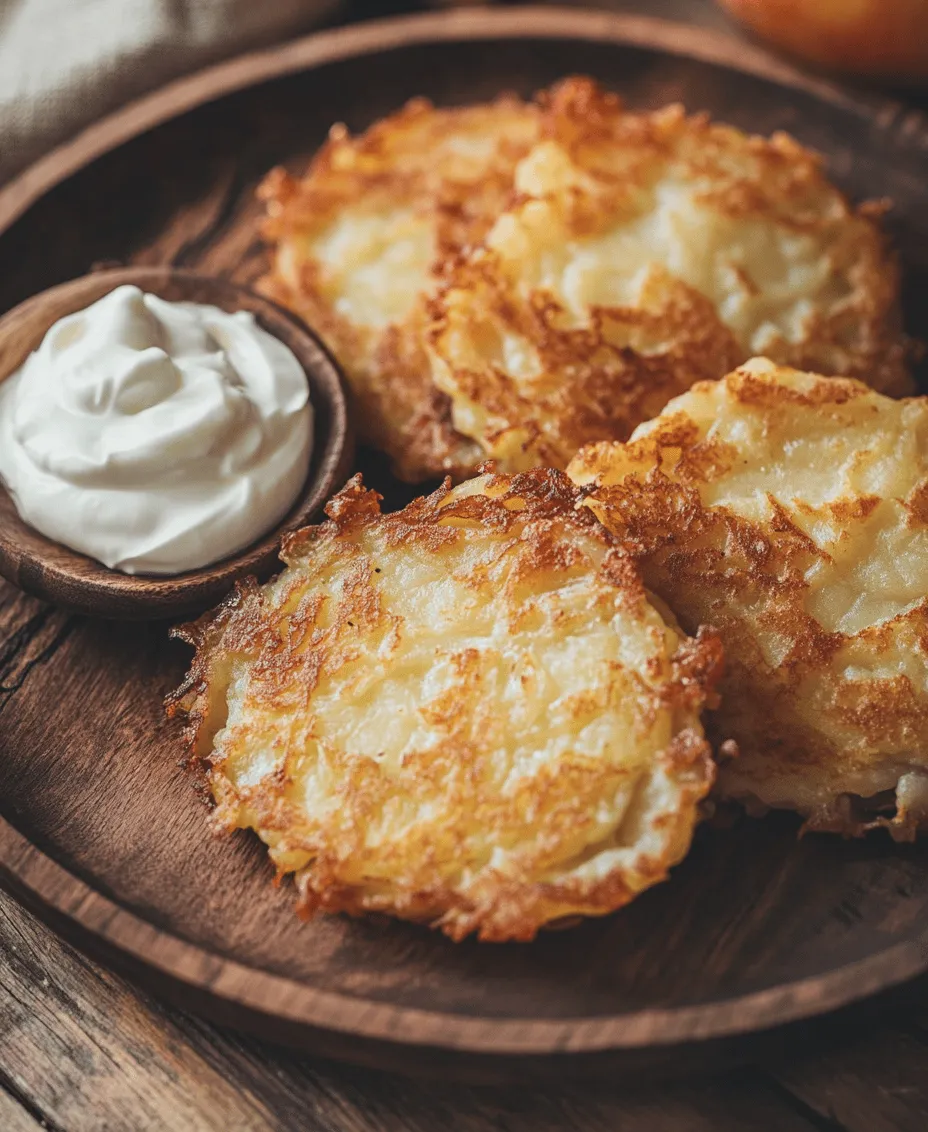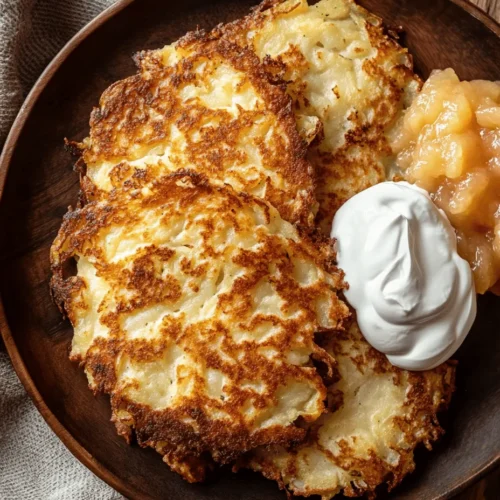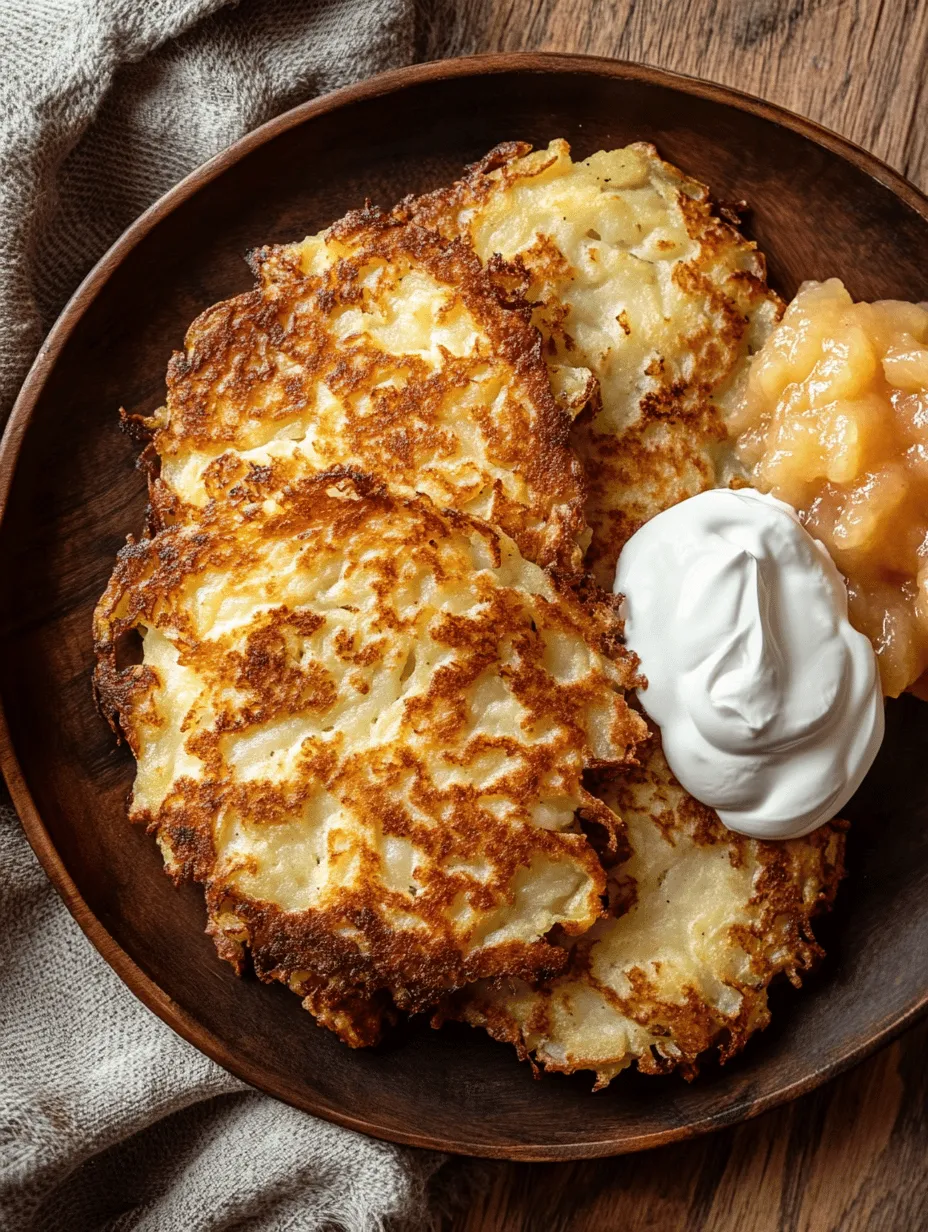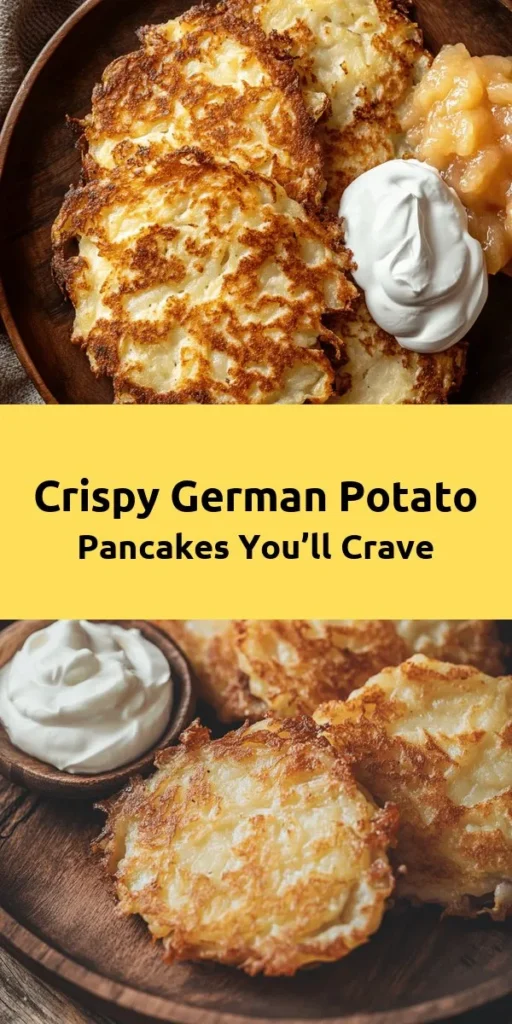Introduction
German cuisine is renowned for its hearty and comforting dishes, deeply rooted in tradition and family gatherings. When one thinks of quintessential German comfort foods, a few classics come to mind: tender bratwurst, rich schnitzel, and of course, crispy German potato pancakes, or *Reibekuchen*. These delectable pancakes are a celebration of simplicity and flavor, showcasing the humble potato in a way that warms both the heart and the palate.
Crispy German potato pancakes are not just a side dish; they are a culinary experience. The perfect *Reibekuchen* boasts a golden-brown exterior that crunches delightfully upon the first bite, giving way to a soft and fluffy interior. This contrast in texture is what makes them so irresistible. Whether served as a snack, a side dish, or even a main course, these pancakes are often accompanied by traditional condiments such as cool sour cream or sweet applesauce, perfectly complementing their savory flavor profile. The balance of crispy and creamy is a hallmark of German cooking that elevates the dining experience.
In the following sections, we will delve into the rich history of these beloved pancakes, explore the key ingredients that contribute to their unique taste, and guide you step-by-step in creating your own crispy German potato pancakes at home.
The Rich History of Potato Pancakes
The origins of potato pancakes can be traced back to the introduction of the potato in Europe in the late 16th century. While potatoes were initially met with skepticism, they quickly became a staple in German cuisine, especially in rural areas where they provided a reliable source of sustenance. Over the years, potato pancakes evolved, and today, they hold a special place in German culture.
In Germany, *Reibekuchen* is not just a dish; it’s a tradition that spans generations. Each region has its own twist on the classic recipe. For example, in the Rhineland, potato pancakes are often enjoyed at fairs and markets, where they are freshly fried and served with a variety of toppings. Meanwhile, in Bavaria, they may be paired with hearty meats or served alongside sauerkraut.
Potato pancakes are especially popular during festive seasons, such as the Christmas markets, where they are enjoyed by locals and tourists alike. The aroma of frying potatoes fills the air, beckoning passersby to indulge in this comforting treat. Such events highlight the communal aspect of cooking, as families and friends gather to share stories and enjoy the fruits of their labor.
The versatility of potato pancakes has allowed them to transcend cultural boundaries, with various adaptations found in different cuisines around the world. From the Jewish *latkes* served during Hanukkah to the Irish *boxty*, the love for crispy potato pancakes is universal, showcasing the potato’s ability to bring people together.
Understanding the Key Ingredients
To create truly exceptional crispy German potato pancakes, it’s essential to understand the role each ingredient plays in the recipe. The following key components are critical to achieving that perfect balance of flavor and texture.
Russet Potatoes
At the heart of every great potato pancake is the potato itself, and for this recipe, russet potatoes are the ideal choice. Their high starch content leads to a fluffy interior while providing the perfect crispiness when fried. Additionally, russet potatoes have a lower moisture content compared to other varieties, which helps prevent the pancakes from becoming soggy. When preparing your potatoes, it’s important to keep them as dry as possible to achieve that coveted crispy texture.
Onion
Onion is another essential ingredient that enhances the flavor of the pancakes. While not all recipes require it, adding grated onion brings a subtle sweetness and depth to the dish. The natural sugars in the onion caramelize during frying, contributing to the overall flavor profile. For those who prefer a milder onion taste, a sweet onion variety can be used, while a sharper onion can provide a more pronounced flavor.
Egg, Flour, and Baking Powder
Eggs serve as a binding agent in potato pancakes, helping to hold the mixture together while adding richness. Flour is another critical component that aids in binding and contributes to the pancakes’ texture. A small amount of baking powder can also be added to the mix, introducing air into the batter and ensuring that the pancakes puff up slightly during frying, resulting in a lighter, crispier texture.
Seasoning: Salt and Pepper
No dish is complete without seasoning, and potato pancakes are no exception. A generous pinch of salt enhances the natural flavors of the potatoes and onions, while freshly ground black pepper adds a touch of warmth and complexity. It’s essential to taste the mixture before frying to ensure the seasoning is balanced, as this will significantly impact the final dish.
Step-by-Step Guide to Making Crispy German Potato Pancakes
Now that we have a solid understanding of the ingredients and their roles, it’s time to dive into the preparation process. Making crispy German potato pancakes is a straightforward endeavor that rewards you with delicious results. Follow these steps to create your own batch of *Reibekuchen*.
Step 1: Gather Your Ingredients
Before you start cooking, ensure you have all the necessary ingredients on hand. For this recipe, you will need:
– 4-5 medium-sized russet potatoes
– 1 medium onion (optional)
– 1 large egg
– 1/4 cup all-purpose flour
– 1/2 teaspoon baking powder
– Salt and pepper to taste
– Vegetable oil for frying
Step 2: Prepare the Potatoes
Begin by peeling the russet potatoes. Once peeled, you’ll want to grate them using a box grater or food processor. The goal is to achieve fine shreds that will cook evenly and provide the right texture. After grating, place the shredded potatoes in a clean kitchen towel or cheesecloth and squeeze out excess moisture. This step is crucial for ensuring the pancakes do not become soggy.
Step 3: Grate the Onion
If you choose to include onion in your recipe, now is the time to grate it. Similar to the potatoes, you want to achieve fine shreds. Once grated, you can mix the onion directly with the potato mixture.
Step 4: Combine Ingredients
In a large mixing bowl, combine the grated potatoes and onion (if using). Add the egg, flour, baking powder, salt, and pepper. Mix until all ingredients are well incorporated. The mixture should be thick enough to hold together but still wet enough to form pancakes.
Step 5: Heat the Oil
In a large skillet, pour in enough vegetable oil to cover the bottom of the pan generously. Heat the oil over medium-high heat. To test if the oil is ready, drop a small amount of the potato mixture into the pan; if it sizzles immediately, the oil is hot enough for frying.
Step 6: Fry the Pancakes
Using a spoon or your hands, form patties from the potato mixture and carefully place them in the hot oil. Be cautious not to overcrowd the pan, as this can lower the oil temperature and prevent the pancakes from becoming crispy. Fry the pancakes for about 4-5 minutes on each side, or until they are golden brown and crispy.
Step 7: Drain and Serve
Once cooked, remove the pancakes from the skillet and place them on a plate lined with paper towels to absorb excess oil. Serve the crispy German potato pancakes warm, alongside sour cream and applesauce for a delightful contrast of flavors.
By following these steps, you will create a dish that captures the essence of German comfort food. The crispy texture, combined with the savory flavor, makes these potato pancakes a dish worth sharing with family and friends. In the next part of the article, we will explore tips for achieving the perfect texture and answers to common questions about making *Reibekuchen*.

Preparing the Potatoes: Techniques for Grating and Moisture Removal
To achieve the perfect crispy texture in your German potato pancakes, the preparation of the potatoes is critical. Start with starchy potatoes like Russets or Yukon Golds, as they yield the best results. Begin by peeling the potatoes, then grate them using a box grater or a food processor fitted with a grating attachment. Aim for fine to medium shreds, which will help create a uniform texture in the pancakes.
After grating, it is essential to remove excess moisture. Wet potatoes can lead to soggy pancakes instead of the desired crispiness. To do this, place the grated potatoes in a clean kitchen towel or cheesecloth. Gather the edges of the towel and twist it to form a pouch, then squeeze firmly to extract as much liquid as possible. Alternatively, you can press the grated potatoes against a fine-mesh sieve or colander, allowing the liquid to drain off. A good rule of thumb is to aim for a moisture content that feels barely damp but not wet. This technique is vital for achieving that signature crunch when frying.
Mixing the Ingredients: Tips for Achieving the Right Consistency
Once your potatoes are ready, it’s time to mix them with the other ingredients. In a large mixing bowl, combine the grated potatoes with finely chopped onions. The onions add flavor and moisture, but be cautious not to use too much, as they can make the mixture too wet. Next, add in the eggs and flour. The eggs act as a binder, holding the mixture together, while the flour adds structure and helps absorb excess moisture.
Start by mixing the ingredients gently with a fork or spatula, ensuring that everything is evenly incorporated. The goal is to achieve a thick batter that holds its shape but is not overly dry. If the mixture seems too loose, add a little more flour, one tablespoon at a time, until you reach the desired consistency. Conversely, if it feels too stiff, a splash of water or an extra egg can help loosen it. Remember that the mixture should be cohesive enough to form patties, yet moist enough to yield tender pancakes.
Heating the Oil: Best Practices for Frying to Ensure Optimal Crispiness
The frying oil is a crucial element in creating crispy German potato pancakes. A good choice for frying is vegetable oil or canola oil, as they have high smoke points and neutral flavors that won’t overshadow the potatoes. Before you start frying, heat the oil in a large skillet over medium-high heat. To test if the oil is ready, drop a small spoonful of the potato mixture into the pan; if it sizzles and bubbles, the oil is hot enough.
For the best results, avoid overcrowding the pan. Fry in batches if necessary, allowing enough space for the pancakes to cook evenly without steaming. If the oil temperature drops too low, the pancakes will absorb excess oil, leading to greasiness instead of crispiness. Maintain an optimal frying temperature by adjusting the heat as needed. If you notice excessive smoking, reduce the heat; conversely, if the pancakes are browning too quickly, lower the heat slightly.
Forming the Pancakes: Techniques for Shaping and Compacting the Mixture
Forming the pancakes is both an art and a science. Use your hands to scoop a portion of the potato mixture, about the size of a golf ball. Gently flatten it into a patty shape, about half an inch thick. Be sure to compact the mixture slightly as you shape it; this will help the pancakes hold together during frying. Aim for uniform thickness to ensure even cooking.
To achieve the perfect shape, consider using a measuring cup or a cookie cutter. This technique can help create uniformly sized pancakes, which not only looks appealing but also ensures they cook evenly. If you find the mixture sticking to your hands, lightly dust your palms with flour to prevent it from adhering. Once shaped, place the pancakes on a tray lined with parchment paper, ready for frying.
Frying the Pancakes: Temperature Control and Frying Time for Perfect Results
When it comes to frying the pancakes, timing is everything. Gently place the formed patties into the hot oil, taking care to avoid splashing. Fry the pancakes for about 3-4 minutes on one side, or until they are golden brown and crispy. Once the first side is cooked, carefully flip them over using a spatula and continue frying for an additional 3-4 minutes on the other side.
Keep an eye on the color and texture; you want a beautiful golden hue. If the pancakes brown too quickly, lower the heat slightly to allow them to cook through without burning. For an added layer of crispiness, you can briefly raise the temperature at the end of cooking for the last minute. This technique adds an extra crunch to the exterior.
Draining Excess Oil: How to Keep Pancakes Crispy Post-Cooking
After frying, it’s essential to drain the excess oil to maintain the crispiness of your potato pancakes. Use a slotted spatula to carefully transfer the cooked pancakes to a plate lined with paper towels. This will absorb any remaining oil. Avoid stacking the pancakes on top of one another, as this can trap steam and moisture, leading to sogginess. Instead, place them in a single layer on the paper towels and keep them warm in a low oven (around 200°F) while you fry the remaining batches.
For an extra touch, you can sprinkle the hot pancakes with a little salt immediately after frying to enhance their flavor. The key to keeping them crispy is to serve them fresh, as they are best enjoyed right after cooking.
Serving Suggestions and Pairings
Traditional Accompaniments: Sour Cream and Applesauce
Crispy German potato pancakes are often served with traditional accompaniments such as sour cream and applesauce. The creamy tang of sour cream pairs beautifully with the savory flavor of the pancakes, creating a delightful balance. On the other hand, the sweetness of applesauce adds a refreshing contrast, enhancing the overall taste experience.
To serve, place a small dollop of sour cream on the side or on top of each pancake. A spoonful of applesauce can also be offered for dipping. This combination not only celebrates the dish’s German heritage but also invites a delightful interplay of flavors.
Exploring Other Serving Options: Variations in Toppings and Sides
While sour cream and applesauce are classic choices, feel free to explore other serving options based on your preferences. Consider topping your pancakes with sliced chives or grated cheese for a savory twist. For a more adventurous approach, try adding smoked salmon or sautéed mushrooms, which can elevate the dish to a gourmet level.
Additionally, these potato pancakes can be served alongside a fresh salad or sauerkraut for a complete meal. The crunch of a green salad or the tang of sauerkraut complements the richness of the pancakes, making for a satisfying dining experience.
The Cultural Significance of These Pairings in German Meals
In German cuisine, accompaniments play a significant role in enhancing the flavors of a dish. The pairing of potato pancakes with sour cream and applesauce is not only traditional but also reflects the German love for balancing flavors and textures. These pairings have been enjoyed for generations and showcase the comforting and hearty nature of German home cooking.
Nutritional Information and Dietary Considerations
Breakdown of Nutritional Values Per Serving
For those mindful of their dietary intake, it’s essential to consider the nutritional values of crispy German potato pancakes. A typical serving of two pancakes (approximately 150 grams) contains roughly:
– Calories: 280
– Protein: 6 grams
– Carbohydrates: 36 grams
– Dietary Fiber: 3 grams
– Fat: 12 grams
– Saturated Fat: 1.5 grams
These values may vary based on the specific ingredients and cooking methods used, so it’s always a good idea to adjust based on your personal recipe.
Possible Substitutions for Dietary Restrictions
For those with dietary restrictions, there are several substitutions you can make while still enjoying the deliciousness of potato pancakes. To create gluten-free pancakes, simply replace regular flour with a gluten-free all-purpose mix or almond flour. For a vegan version, substitute the eggs with a flaxseed meal (1 tablespoon of flaxseed meal mixed with 2.5 tablespoons of water equals one egg) or unsweetened applesauce, which can help bind the ingredients together while adding a touch of sweetness.
Discussion on Moderation and Balance in Indulgent Recipes
While crispy German potato pancakes are undeniably a treat, it’s important to enjoy them in moderation as part of a balanced diet. Pairing them with fresh vegetables or a light salad can enhance the meal’s nutritional value while allowing you to indulge in the comforting flavors of this classic dish.
Conclusion
Crispy German potato pancakes are a delightful and easy-to-make dish that brings a taste of Germany right to your kitchen. With their irresistible crunch and hearty flavor, they are perfect for breakfast, lunch, or dinner. The preparation techniques, frying tips, and serving suggestions outlined above ensure that you can achieve perfect pancakes every time.
I encourage you to try this recipe and experience the joy of cooking and sharing a piece of German tradition with your family and friends. There’s something truly special about homemade food, and these crispy potato pancakes are sure to become a beloved favorite in your household. Celebrate the love of cooking and the joy of good food by making and sharing these delicious pancakes with those you cherish.



